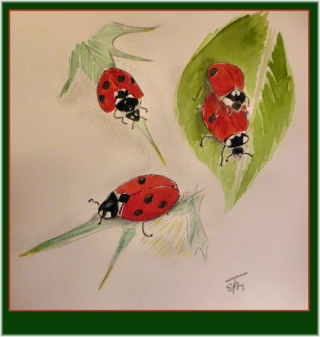Category: Drawing Traditional Art
Post Type:
Traditional Art
Mixed Media: None | Pencil drawing, watercolour wash mounted & framed
Pays
one point
and 2 member cents.





© Copyright 2024. Susan F. M. T. All rights reserved. Registered copyright with FanArtReview.
Susan F. M. T. has granted FanStory.com, its affiliates and its syndicates non-exclusive rights to display this work.
Posted: November 28, 2018
      |
Ladybird ~ Coccinellidae
Ladybirds for Ena
by Susan F. M. T.
Interested in this? Contact The Artist
My cousin Ena, is a mature student reading Horticulture at University, she asked me to paint her three Ladybirds as she maintains she can't draw a straight line...(I don't beleive that, we can all draw but very few of us & I'm not one of them can be Renoir or Monet)
This was my effort at the Ladybird not a work of art just three painted sketches.
I just found these interesting facts about them:-
Who doesn't love a ladybug? Also known as ladybirds or lady beetles, the little red bugs are beloved because they are beneficial predators, cheerfully chomping on garden pests such as aphids. But ladybugs aren't really bugs at all. Instead, ladybugs belong to the order Coleoptera, which includes all the beetles. Europeans have called these dome-backed beetles by the name ladybirds, or ladybird beetles, for over 500 years. In America, the name "ladybug" is preferred; but scientists usually prefer the common name lady beetles, because it is a more accurate term.
According to legend, European crops during the Middle Ages were plagued by pests. Farmers began praying to the Blessed Lady, the Virgin Mary. Soon, the farmers started seeing beneficial ladybugs in their fields, and the crops were miraculously saved from the pests. The farmers began calling the red and black beetles "our lady's birds" or lady beetles. In Germany, these insects go by the name Marienkafer, which means "Mary beetles." The seven-spotted lady beetle is believed to be the first one named for the Virgin Mary; the red color is said to represent her cloak, and the black spots her seven sorrows.
Startle an adult ladybug, and its foul-smelling hemolymph will seep from its leg joints, leaving yellow stains on the surface below. Potential predators may be deterred by the vile-smelling mix of alkaloids and equally repulsed by the sight of a seemingly sickly beetle. Ladybug larvae can also ooze alkaloids from their abdomens.
Like many other insects, ladybugs use aposematic coloration to signal their toxicity to would-be predators. Insect-eating birds and other animals learn to avoid meals that come in red and black and are more likely to steer clear of a ladybug lunch.
Susan
by Susan F. M. T. Interested in this? Contact The Artist
This was my effort at the Ladybird not a work of art just three painted sketches.
I just found these interesting facts about them:-
Who doesn't love a ladybug? Also known as ladybirds or lady beetles, the little red bugs are beloved because they are beneficial predators, cheerfully chomping on garden pests such as aphids. But ladybugs aren't really bugs at all. Instead, ladybugs belong to the order Coleoptera, which includes all the beetles. Europeans have called these dome-backed beetles by the name ladybirds, or ladybird beetles, for over 500 years. In America, the name "ladybug" is preferred; but scientists usually prefer the common name lady beetles, because it is a more accurate term.
According to legend, European crops during the Middle Ages were plagued by pests. Farmers began praying to the Blessed Lady, the Virgin Mary. Soon, the farmers started seeing beneficial ladybugs in their fields, and the crops were miraculously saved from the pests. The farmers began calling the red and black beetles "our lady's birds" or lady beetles. In Germany, these insects go by the name Marienkafer, which means "Mary beetles." The seven-spotted lady beetle is believed to be the first one named for the Virgin Mary; the red color is said to represent her cloak, and the black spots her seven sorrows.
Startle an adult ladybug, and its foul-smelling hemolymph will seep from its leg joints, leaving yellow stains on the surface below. Potential predators may be deterred by the vile-smelling mix of alkaloids and equally repulsed by the sight of a seemingly sickly beetle. Ladybug larvae can also ooze alkaloids from their abdomens.
Like many other insects, ladybugs use aposematic coloration to signal their toxicity to would-be predators. Insect-eating birds and other animals learn to avoid meals that come in red and black and are more likely to steer clear of a ladybug lunch.
Susan
Mixed Media: None | Pencil drawing, watercolour wash mounted & framed
 Recognized |


Ladybirds for Ena
by Susan F. M. T.

You need to login or register to write reviews. It's quick! We only ask four questions to new members.
© Copyright 2024. Susan F. M. T. All rights reserved. Registered copyright with FanArtReview.

Susan F. M. T. has granted FanStory.com, its affiliates and its syndicates non-exclusive rights to display this work.

